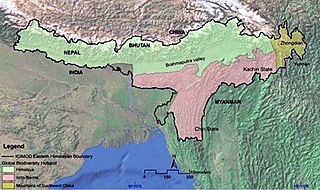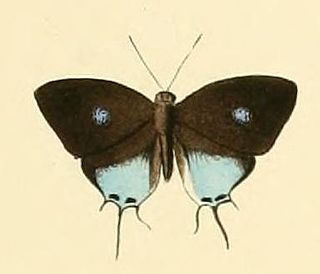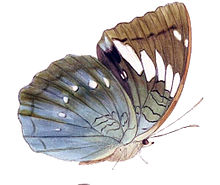
Bhutan's early history is steeped in mythology and remains obscure. Some of the structures provide evidence that the region has been settled as early as 2000 BC. According to a legend it was ruled by a Cooch-Behar king, Sangaldip, around the 7th century BC, but not much is known prior to the introduction of Tibetan Buddhism in the 9th century, when turmoil in Tibet forced many monks to flee to Bhutan. In the 12th century, the Drukpa Kagyupa school was established and remains the dominant form of Buddhism in Bhutan today. The country's political history is intimately tied to its religious history and relations among the various monastic schools and monasteries.

Northeast India is the easternmost region of India representing both a geographic and political administrative division of the country. It comprises eight states – Arunachal Pradesh, Assam, Manipur, Meghalaya, Mizoram, Nagaland, Tripura and Sikkim.
Assam Himalaya is a traditional designation for the portion of the Himalaya range between the eastern border of Bhutan, on the west, and the Great Bend of the Tsangpo River, on the east. The highest peak of this range is Namcha Barwa. Other high peaks include Gyala Peri, sister peak to Namcha Barwa; Kangto, and Nyegyi Kansang. The area is still poorly surveyed in general, and little visited by outsiders. It is located in the eastern side. The name "Assam Himalaya" is misleading, as some parts of this range are in southeastern Tibet, while other parts are in Bhutan and the Indian regions and states of northern Assam, Sikkim, and Arunachal Pradesh.

Byasa plutonius, the Chinese windmill, is a butterfly found in Asia that belongs to the windmills genus (Byasa), comprising tailed black swallowtail butterflies with white spots and red submarginal crescents.

Arhopala eumolphus, the green oakblue, is a lycaenid butterfly found in the Indomalayan realm. The species was first described by Pieter Cramer in 1780.

The Eastern Himalayas extend from eastern Nepal across Northeast India, Bhutan, the Tibet Autonomous Region to Yunnan in China and northern Myanmar. The climate of this region is influenced by the monsoon of South Asia from June to September. It is a biodiversity hotspot, with notable biocultural diversity.

Plectocomia is a genus of flowering plant in the family Arecaceae native to China, the Himalayas, and Southeast Asia. Plants are dioecious, with male and female flowers produced on separate individuals. It contains the following known species:

Bassarona teuta, the banded marquis, is a species of nymphalid butterfly.

The Kingdom of Bhutan is a small, landlocked nation nestled in the southern slopes of the Eastern Himalaya. To its north lies the Tibet Autonomous Region of China and to the west, south and east lies the Indian states of Sikkim, Bengal, Assam and Arunachal Pradesh.

Sashastra Seema Bal (SSB) is a border guarding force of India deployed along its border with Nepal and Bhutan. It is one of the five Central Armed Police Forces under the administrative control of the Ministry of Home Affairs (MHA).

Slavery in Bhutan was a common legal, economic, and social institution until its abolition in 1958. In historical records, unfree labourers in Bhutan were referred to as slaves, coolies, and serfs. These labourers originated mostly in and around Bhutan, Assam, and Sikkim, and were the backbone of Bhutan's pre-money feudal economy.

Molineria is a genus of flowering plants. In the APG III classification system, it is placed in the family Hypoxidaceae. It is native to Southeast Asia, China, the Indian Subcontinent, Papuasia, and Queensland.
- Molineria capitulata(Lour.) Herb. - China, Indian Subcontinent, Southeast Asia, Papuasia, Queensland; naturalized in Mexico, Central America, West Indies, Argentina, Mauritius, Réunion
- Molineria crassifoliaBaker - Nepal, Assam, Bhutan, Sikkim, Yunnan, Arunachal Pradesh
- Molineria gracilisKurz - southern China, Assam, Bhutan, Nepal, Cambodia, Thailand, Vietnam
- Molineria latifolia(Dryand. ex W.T.Aiton) Herb. ex Kurz - China, Bangladesh, Indochina, Philippines, western Indonesia, Borneo
- Molineria oliganthaC.E.C.Fisch. - Assam
- Molineria prainianaDeb - Assam, Bhutan
- Molineria trichocarpa(Wight) N.P.Balakr. - southern India, Sri Lanka

Neptis cartica, the plain sailer, is a species of nymphalid butterfly found in South Asia.

Lohorung are a major subgroup of Rai people and ethnic native people of eastern Nepal. The Lohorung homeland is Sankhuwasabha district in the northern part of the Arun watershed, a tributary to the Koshi. At present they are found in eight other districts of Nepal: Ilam, Jhapa, Sunsari, Morang, Dhankuta, Terhathum, Lalitpur and Kathmandu. They also live in northeastern states of India: Darjeeling and Kalimpong in West Bengal, Sikkim and Assam, and even Bhutan, Australia, United Kingdom and United States.

Drupadia scaeva, the blue posy, is a species of butterfly of the family Lycaenidae. It is found in South-East Asia.
Allium prattii is an Asian species of wild onion native to Assam, Nepal, Sikkim, Bhutan, and China. It is found at elevations of 2000–4900 m.
Bhutanthera is a genus of terrestrial orchids native to the Himalaya Mountains of Asia.

Neope is a genus of butterflies of the family Nymphalidae found in Asia.

Eastern South Asia is a subregion of South Asia. It includes the countries of Bangladesh, Bhutan, India, and Nepal. Geographically, it lies between the Eastern Himalayas and the Bay of Bengal. Two of the world's largest rivers, the Ganges and the Brahmaputra, flow into the sea through Eastern South Asia. The region includes the world's highest mountainous terrain and the world's largest delta, and has a climate ranging from alpine and subalpine to subtropical and tropical. Since Nepal, Bhutan, and northeast India are landlocked, the coastlines of Bangladesh and East India serve as the principal gateways to the region.

















